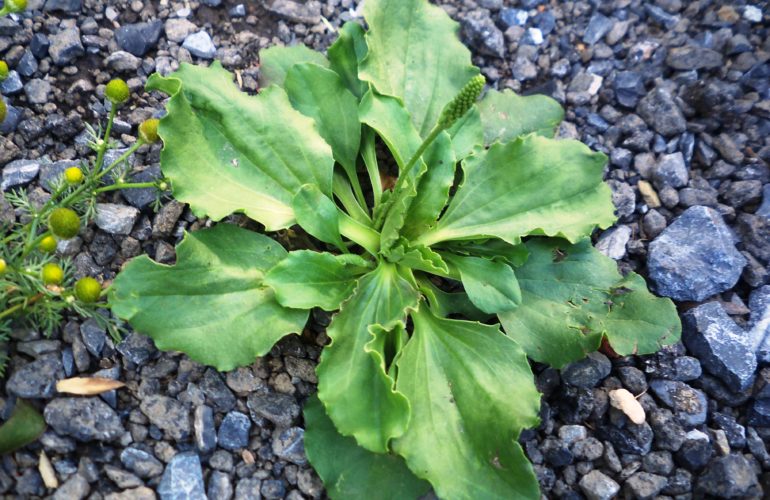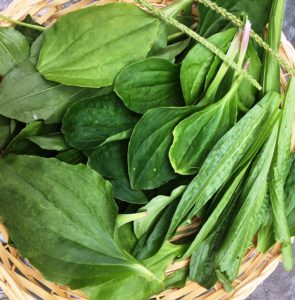
Everybody who spends any time outdoors has seen plantain (Plantago spp). If they have a lawn to care for, plantain is the plant that sends up the seed heads on stalks, waving five or six inches above the grass within a day or two after it’s been mowed. It also appears to be the salad of choice for the herds of rabbits that run like schools of fishes through the tree farm where I live.
Not to be confused with the mild cooking bananas, this plant grows in a basal rosette. The leaves of the two most common species (major and lanceolata) in most of the US have ribs all the way from the stem to the leaf-tip that are reminiscent of the strings in celery. Some nicknames for the plant include rabbit ears, ribwort, white man’s footprint (as Europeans traveled, plantain went with them), and devil’s shoestring – among many others.

The leaves of plantago major and lanceolata
Knowing this unassuming plant is like having a medicine chest along the trail wherever you go. It contains allantoin (main active ingredient in Neosporin) and mucilage to speed healing of wounds, and vitamin K to help with blood clotting.
One of the most amazing properties of plantain is the way it draws, making it incredibly useful in the case of insect bites and stings by pulling the venom or saliva out. It is also effective for things like splinters. In order to do this, we use something called a “spit poultice” that is made by simply chewing a plantain leaf or two just until it is a consistency that can be applied to the skin. It acts very quickly, especially if used immediately.
Young plantain leaves can be eaten before they become tough, and are very safe. The seed husk of a couple varieties, most notably Plantago psyllium are used commercially as a bulk laxative.
Plantain is also anti-inflammatory, anti-microbial, antispasmodic, astringent, analgesic, and decongestant. This makes it a good trail nibble for someone suffering from digestion issues (that’s no fun!) or upper respiratory symptoms. In higher altitudes, it can be a soothing moisturizing tea. That same tea can be used as a wash on rashes and sunburn.
Take a few minutes to learn to recognize this plant and it will always be available when you need it.
Tina Sams, Editor
The Essential Herbal




